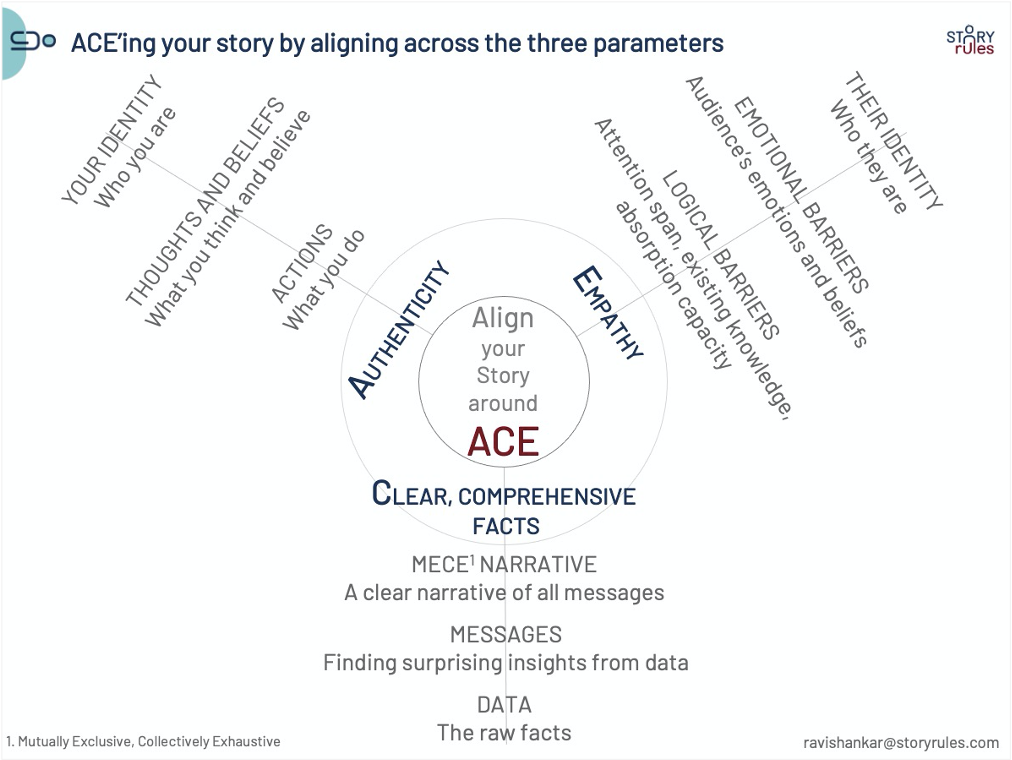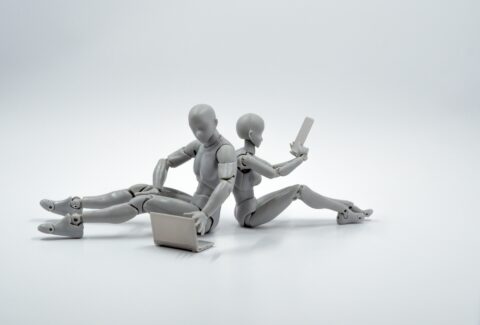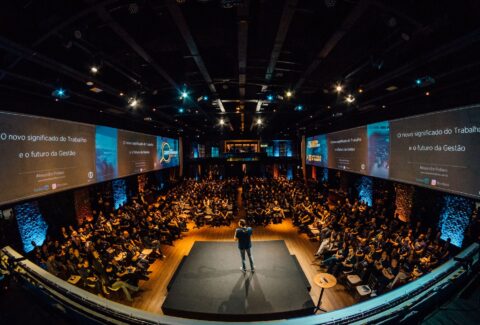ACE your story by aligning with Authenticity, Empathy and the Clear, Comprehensive Facts

ACE your story by aligning with Authenticity, Empathy and the Clear, Comprehensive Facts
The stories you tell at work need to be aligned at three levels:
- Authenticity,
- Clear, comprehensive facts and
- Empathy.
What happens in case of misalignment? Let’s explore through three fictional stories:
1: Dan leads a business division in a large company. His division outperforms the others and he leads from the front. However, he can be abrasive and disrespectful to employees and peers. If someone commits even a genuine mistake, they are due for a massive tongue-lashing from him.
And yet, recently during the company’s 50-year celebration, when Dan was asked to speak about the company’s values, he waxed eloquent about them.
Especially about one value: Respect.
In fact, Dan told a stirring story about his ex-boss who had instilled that value among his team.
Dan’s team cringed in their seats, shaking their head in disgust.
But those from the audience who had never worked with Dan were extremely impressed. You see, Dan was a good ‘storyteller’.
Except, he was not.
Because he is missing a key tenet of storytelling at work: Authenticity.
Authenticity requires that your words are aligned with your thoughts, beliefs – and most importantly your actions.
How many times have we rolled our eyes while a leader spews empty rhetoric about employee-welfare, about vendors being partners and about driving stakeholder value…
Words without the actions to back them, ring hollow.
What’s worse: If the said wordsmith is a ‘good storyteller’, then his or her inauthenticity gives the whole skill of storytelling a bad name. Folks get turned off by such con-artists and think – “I want the truth, not your ‘stories’”.
So, to all the ‘Dans’ of the world: Don’t be that inauthentic storyteller. Align your actions, beliefs and words.
2: Samir is an influential social entrepreneur who works in the field of skill development for youth. He firmly believes that the answer to India’s unemployment problem is to provide short-term entrepreneurship training programs (preferably free of cost) to youth and get them to start businesses of their own. His contention: ‘Let them start businesses and create jobs, instead of asking for them’.
This strong belief (and actions that support the same) makes Samir an authentic communicator.
He is also extremely persuasive and articulate, making it easy to convince donors to fund his projects.
Sounds great right, what’s the hitch?
The hitch is data.
It turns out that the facts-on-the-ground don’t support Samir’s beliefs. India doesn’t have an unemployment problem as much as an under-employment problem. The data also shows that short-term courses are unable to make any meaningful impact on the students learning. And finally, entrepreneurship is not everyone’s cup of tea – most of India’s ‘street-entrepreneurs’ do what they do because of compulsion, not choice.
So what is the solution? It’s not easy, and it needs a strong drive and effort to dig into the data and uncover what works. How have other similar countries done it? What examples can we see in India that are working? Is there a product that the market will pay for? What experiments can we run to see what works…
In other words, a commitment to find the clear, comprehensive facts.
Without that, your story may be ‘authentic’ (in that, it’s aligned to your beliefs and actions) – but it may not be true.
3: Priyanka is the CTO of a fast-growing financial services organisation. She comes from a solid tech background and is a geek to the core.
She follows the latest advances in technology and is excited to implement some of them at her company. There is a problem, however.
Her counterparts don’t ‘get’ her.
‘Gosh, these guys ask so many random questions (especially that CFO!). Why don’t they just trust her judgement and sign the cheques, dammit?!’
Priyanka is authentic and has the facts on her side. But she’s missing the crucial third ingredient.
Empathy.
Priyanka has to see the issue from her audience’s point of view and reframe her pitch accordingly. For instance, if a new technology has come in, she has to help them get the context of the same and how critical is it in the organisation’s scheme of things. Is the new technology a move akin to ‘feature-phones-to-smartphones’? Or is it more like ‘iPhone-11-to-iPhone-12’?
Using analogies, human stories and other techniques, Priyanka can ensure that her message gets through to her audience.
Here’s another story on the third element. This one actually happened:
3a: During my consulting years, a sharp, dedicated young consultant (let’s call her Mita) was reporting to me. Mita was a hard taskmaster (which is ok) but lacked empathy (which is not).
While reviewing the work of an associate, she found some shortcomings. She then proceeded to admonish her very bluntly… in her open cubicle, with the entire rest of the teams within earshot.
Forget the impact this had on the poor associate (which would have been traumatic)… but such interactions also make other passive listeners uncomfortable and squirm in their seats.
Now Mita was being authentic – and perhaps there was ‘data’ to admonish the associate… but there’s a way of doing it that takes into account the person’s feelings.
And so, soon after the interaction, I messaged to Mita to join me in a cabin and explained to her why it’s ok to admonish, but it’s not ok to do it in front of everyone. Mita immediately apologised and promised she’d take care in the future.
So just like Priyanka needs to be empathetic to how her audience thinks, Mita needs to be empathetic to how her audience feels.
In sum, as a good storyteller, you need to ACE your story by aligning across the three parameters: Authenticity, Clear, comprehensive facts and Empathy.

Let’s see what happens when the story is misaligned with any one of the aspects:
1. No authenticity:
You say one thing but your actions indicate something else… If you do it often enough, your words cease to have meaning. They become empty ‘rhetoric’.
(Some of you might cynically say – Aren’t you talking about all politicians here?)
a. The politics exception: In politics, authenticity might be a liability. A politician depends upon your vote and so is wary of telling (what might be) the bitter truth to any audience. And so many of them rely on obfuscation, subterfuge and plain ol’ lies to get by. Of course, there have been many instances of politicians being authentic and yet massively popular (Gandhi, Mandela, Martin Luther King)…
Some politicians use craftiness strategically, for the greater good. One of the best examples in India is that of the ex-Prime Minister Narasimha Rao, who was pragmatic and shrewd in convincing India’s communist parties to support the path-breaking liberalisation agenda that his Finance Minister, Dr Manmohan Singh was proposing.
All in all, I will keep ‘politics’ out of the realm of authenticity in storytelling
b. Authenticity at work: At work too, sometimes people may omit saying something or say something false, for “the greater good”. Barring such exceptional cases, authenticity is a valuable trait at work. If your words and actions frequently mismatch, then you will lose credibility and will struggle to convince others to do your bidding. Authenticity gives you Ethos – a crucial element in Aristotle’s three appeals. It may hurt in the short term but will benefit you in the long term.
2. No Clear Comprehensive Facts:
An authentic, empathetic plea might convince your audience – but because it lacks the solid foundation of facts, it may end up resulting in a sub-optimal outcome.
I used to see this quite a bit in the social-impact world. A lot of highly authentic folks, whose hearts would bleed for their constituents, would propose emotion-laden plans which may warm hearts but not result in on-ground improvement. Here’s a story I had written about earlier on this topic.
What muddles the facts are that they are tough to pin down. We are not machines with the ability to calmly process all facts – we come with our own biases and beliefs. We often seek data to confirm our biases.
Now, this article is not a treatise on managing cognitive biases. But my limited point is that we need to be cognizant of our mental failings and biases when dealing with data. The truth can be messy, complicated, challenging, and yes, bitter. When studying the data, we should resist the temptation to fit simple, convenient stories that fit the existing narrative in our minds.
In this earlier post, I have put down a structured way to approach your data-research exercise.
3. No Empathy:
Think of your audience’s brain as a castle with three moats – logic, emotions and identity. As a storyteller, you need to mould and equip your story with the right tools to surmount these barriers.
a. Logical barriers:
We live in an information-dense and attention-sparse world. Your audience’s attention is a fickle commodity and confusion is a mortal enemy. The confusion may be a result of two reasons:
(i) The audience doesn’t ‘get’ a particular idea that you are trying to say, because it is too technical, complex or different
In such situations, the best approach is to simplify the concept and make it relatable to the audience. You can use many storytelling techniques such as: human stories, analogies, simple visuals, mystery, anthropomorphisation (that last one’s a handful to spell!).
Here’s an old post where I had shared seven techniques to present complex, technical information in a simple way.
(ii) The audience gets individual pieces but struggles to get the overall narrative
This is probably the most common barrier I see because presenters rarely take the effort of building a clear narrative flow. If the audience feels that the content lacks a logical flow, they may mentally check out of the conversation.
Here are three ideas you can use to solve for logical barriers:
– Craft your narrative on paper before starting on your presentation/report. Here’s an old post I’d written about how to get your story narrative in shape.
– A good way to build flow between statements/messages is to use the right ‘connecting words’. Here’s an old post about five words/phrases you can use to build such connections.
– When actually presenting, ensure smooth transitions between topics/slides in your presentation. Always give your audience the ‘big-picture’ view of what’s been covered so far, and what’s coming up next.
b. Emotional barriers:
Emotions are omnipresent, and a good storyteller should keep them in mind when crafting the story.
There are three kinds of emotional barriers presenters face:
(i) Disengagement/boredom:
Let’s face it. Nobody is “looking forward” to a quarterly review or a vendor pitch. We get bored and distracted easily – which means as storytellers, you need to engage the audience.
Enter the emotions, surprise and curiosity. You need to use the principle of norm-and-variance to surprise the audience and get their attention (here’s a post about that).
And then leverage their curiosity by releasing information in bite-sized pieces. One critical way to do that is to use the principle of conflict-resolution. Don’t give the answer to the audience before you have shown the challenge/issue that the answer is resolving. (here’s an old post about that too!).
At the same time, your story needs to have a balance between novelty and familiarity. (And, not to brag, here’s an old post about that!)
(ii) Negative emotional reaction to information being presented
This is one of the toughest barriers storytellers face. You may hit the emotional buttons of the audience for any number of reasons. The audience may not like:
- What the data is telling
- Your opinion or recommendation based on the data
- Your voice tone/body language when you present the data
- Their assumption of your intent when you say or do something…
Any of these may prompt a reaction of fear, anger, shame, disgust or worse – a mix of all these emotions.
How do you tackle such situations? By being genuinely empathetic. Which means not just paying attention to what you are saying, but also how you are saying it.
- If you have bad news that would result in an emotional reaction, consider breaking the news gently. Don’t shock the audience.
- Be genuinely empathetic and let the tone in your voice and your body language reflect what you feel for the audience.
- At the same time, be firm. If bad news has to be given, it needs to be given. In doing so, especially for senior audiences, practise the “What-Why-What next” approach to share the bad news.
Emotions in storytelling is a vast topic of its own. I look forward to exploring it deeper in a later post.
(iii) Lack of trust/credibility
In storytelling we often focus on What to say, How to say it or Why to say something. We sometimes miss out on another important aspect: ‘Who’ said (or should say) it. If the audience does not trust the person delivering the message, then no amount of logic or emotional resonance will help. Trust makes up the ‘Ethos’ part of the ‘Ethos-Pathos-Logos‘ framework
In your work, if you are struggling to get a point of view across to your boss or client, ask yourself: Who would have greater credibility/authority to say this? Maybe a prominent customer voicing her pain point? Maybe a respected industry expert?
In this post, I use a couple of simple examples to illustrate this point.
c. Identity barriers
Identity goes to the core of our being – the values and beliefs that define us. These have been formed over years, if not decades. A single story, howsoever powerful, would not be able to surmount the identity barrier.
Identity is like hard rock – the only way to change/mould it is through steady, sustained erosion. Honestly, beyond that platitude, I don’t have anything more on this aspect as of now!
—-
In sum, a good storyteller displays these three traits:
- Authenticity
- Clear, comprehensive truth
- Empathy
Here’s wishing that you ACE the stories in your life!
Ravi
PS: I didn’t set out to write a ‘container’ for all my previous blog posts. ;p
But as I was expanding on the topics, I realised that I had written about some of these earlier. And instead of making this article super-long, I decided to tag the relevant posts to this structure.







